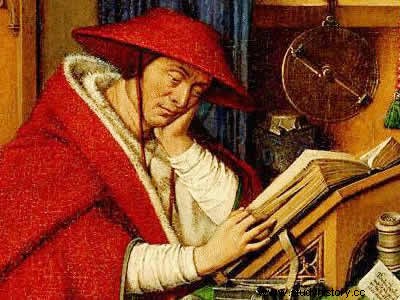
By Rainer Sousa
For those who today see the practicality offered by e-books, cannot even imagine the long path taken by books in History. Companion to writing, books had great importance for the realization of historical records, the compilation of laws and the dissemination of ideas. Currently, the production of books has reached such a point that, for example, the 20th century was responsible for a historical literature superior to that of all the other centuries combined!
In Ancient Egypt, the ancestor of books was conceived through papyrus. Transformed into an important activity, writing on papyrus was exclusively performed by a class of scribes responsible for reading and manufacturing official and religious texts. Researchers point out that the oldest pieces of papyrus ever found were conceived three thousand years before Christ. To organize these documents, the papyrus sheets were nailed together to form a single roll.
About the 10th century BC. C., the organization of written documents gained greater functionality with the invention of parchments. Despite not having the same practicality as the bound ones, this material base was of paramount importance for the preservation of important texts from antiquity, such as the Holy Bible and the writings of some thinkers of the classical world. It is worth noting that the quality and strength of the parchments was superior to that of papyrus.
The design of the bound book was already being attempted at that time. To do so, they took the available parchments and organized each of the supposed pages. Known as codex (codex, in Portuguese) these first editions facilitated the locomotion and handling of written texts. At the end of antiquity, around 404, St. Jerome recorded an extensive theory about the ways in which it would be possible to produce a book.
In the medieval period, access to the literate world was practically restricted to clerics. Many of the books were cloistered under the protection of the monasteries and their wisdom was preserved by the time-consuming work of copyist monks. In this regard, it is important to emphasize that the Church played a fundamental role in preserving various texts from Greek and Roman culture. At that time, it was common for so-called illuminations to decorate the footnotes and paragraphs of books with beautiful images.
In 1454, the process of making and publishing books underwent a giant qualitative leap with the invention of the printing press. Developed by Johannes Gutenberg, this machine allowed the bookmaking process to be streamlined. Despite the importance of the feat, we observed that in the Modern Age reading and writing were still linked to the privileges enjoyed by the elites. Reading and writing were pleasures still destined for the wealthy nobles and bourgeois.
The 19th century, as a child of technological innovations, marked a time of great productions. It is worth noting that the liberalization process of the National States had a great influence on the dissemination of public education and the consequent increase in the number of readers. With the cheapening of production costs, reading began to reach large portions of the population. From then on, the famous and still highly sought after “best sellers” were born. .
